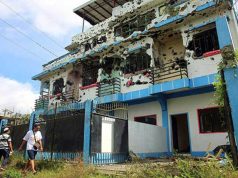A tactically smart, social media savvy group eager to align with Islamic State has emerged from the glut of bandit and separatist groups in the southern Philippines, and so far has proved to be more than a match for the military.
Maute guerrillas seized large parts of Marawi, a predominantly Muslim city in the Mindanao region, on Tuesday after a botched raid by security forces on a hideout of the group.
Fighting abated on Wednesday, but residents said fighters were in control of the city, 1,400 km (870 miles) south of the capital Manila. They allowed many civilians to leave, although they had taken a Catholic priest hostage.
President Rodrigo Duterte has imposed martial law across Mindanao, saying he would use tough measures to prevent a “contamination” by Islamist extremists in the region, which comprises one-third of the sprawling, Catholic-majority Philippines.
“The Philippines is facing a dangerous group with more solid international connections,” security expert Rommel Banlaoi said of the Maute.
“This will be a game-changer in the fight against Islamist extremism, we haven’t seen anything like this before.”
The Philippines has long fought a simmering Islamic insurgency in Mindanao, but it has signed peace deals with some of the main militant groups and contained others. The region is also home to Marxist guerrillas as well as bandit gangs.
Based in Lanao del Sur, the Mindanao province which includes Marawi, the Maute surfaced around 2013 with a bombing of a nightclub in Cagayan de Oro, a mainly Christian city in a neighboring province, which killed six people.
The little-known group has raised its profile since Duterte took office 11 months ago, most notably with a September 2016 bombing of a street market in the president’s hometown of Davao City. Fourteen people were killed and dozens wounded.
It was blamed for a foiled bomb attempt near the United States embassy in Manila in November.
MIDDLE EAST LINKS
The group is named after its leaders, the Maute brothers, both Filipinos with extensive ties to the Middle East, according to the military.
Egypt-educated Omarkhayan Romato Maute married an Indonesian, the daughter of a conservative Islamic cleric, while his brother Abdullah studied in Jordan and has links to Arab extremists. A third brother Hashim was arrested but escaped from a Marawi jail last year.
Last year, the group sought recognition from the Islamic State, pledging allegiance and calling itself as the IS-Ranao.
The Maute brothers are cousins of the second wife of Alim Abdulaziz Mimbantas, a leader of the separatist Moro Islamic Liberation Front (MILF) who is now dead. The government signed a peace deal with the MILF in 2014.
Military intelligence said the Maute brothers also had links to two of the region’s most dangerous militants – Indonesian Ustadz Sanusi and Malaysian bomb maker Zulkifli bin Hir, alias Marwan. Both were killed by Philippine security forces, Sanusi in 2012 and bin Hir in 2015.
In an October 2016 report, regional security expert Sidney Jones said the Maute “has the smartest, best-educated and most sophisticated members of all of the pro-ISIS groups in the Philippines”.
Jones said the Maute group was sophisticated in its use of social media and was able to attract students and teachers from the Mindanao State University in Marawi.
The Philippines had until this year denied it was home to groups with Islamic State ties. In February, Defence Secretary Delfin Lorenzana told Reuters there was credible intelligence showing Islamic State was providing funds and sounding out the Philippines as a base.
The military has not had much success in battles with Maute fighters, despite far greater numbers and use of planes, attack helicopters and artillery.
“The Mautes have shown an ability to absorb what would seem to be major losses in clashes with the police and military, suggesting that their organization is larger and better organized that perhaps they have been given credit for,” Jones said in the report.
Military officials say it is not possible to estimate the number of Maute fighters – some reports have put the number of at over 100, but others say there could be about 1,000.
What is troubling the security apparatus is that radical elements of another Islamic State-linked group, Abu Sayyaf, appear to be collaborating with Maute, far from its island strongholds of Basilan, Jolo and Tawi Tawi, all off Mindanao.
The military says Isnilon Hapilon, a leader of the Abu Sayyaf group notorious for kidnappings and piracy, sought an alliance with the Maute brothers and was wounded in air strikes in January in Lanao del Sur.
Hapilon, who is also wanted by the United States, was the target of Tuesday’s attempted raid in Marawi, but was not captured.










